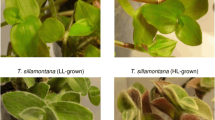Summary
This article describes the effect of water stress on the room temperature chlorophyll fluorescence lifetime of plants of wheat (C3) and maize (C4). In addition, net CO2 assimilation rate (P N ), stomatal conductance and the fluorescence quenching coefficientsqP andqNP at steady state conditions were recorded. The overall fluorescence decay of the control plants can be described by an average decay time of 1 ns for both plant types. Water stress did not modify this parameter in the case of wheat, whereas a shortening of the decay was observed for waterstressed maize plants (τ=0.45 ns). This shortening in the chlorophyll fluorescence decay was accompanied by an increase in the nonphotochemical quenching (qNP). The photochemical quenching (qP) and therefore the electron transport via photosystem II remains unaffected by water stress. The most pronounced effect of the stress for both plant types was a decrease inP N due to a closure of the stomata.
Similar content being viewed by others
References
Caemmerer S, Farquhar GD (1981) Some relationships between the biochemistry of photosynthesis and the gas exchange of leaves. Planta 153:376–387
Hodges M, Moya I (1986) Time-resolved chlorophyll fluorescence studies of photosynthetic membranes: resolution and characterization of four kinetic components. Biochim Biophys Acta 849:193–202
Hodges M, Moya I (1988) Time-resolved chlorophyll fluorescence studies on pigment protein complexes from photosynthetic membranes. Biochim Biophys Acta 935:41–52
Lichtenthaler HK (1987) Chlorophylls and carotenoids, the pigments of the photosynthetic biomembranes. Methods Enzymol 148:350–382
Lichtenthaler HK, Rinderle U (1988) The role of chlorophyll fluorescence in the detection of stress conditions of plants. CR Anal Chem 19:29–85
Schmuck G, Verdebout J, Koechler C, Moya I, Goulas I (1990) Laser-induced time-resolved fluorescence of vegetation. Proc Internat Geoscience and Remote Sensing Symposium, IGARSS '90, Univ of Maryland, vol II, pp 1923–1926
Schneckenburger H, Frenz M (1986) Time-resolved fluorescence of conifers exposed to environmental pollutants. Radiat Environ Biophys 25:289–295
Scholander PF, Hammel HT, Bradstreet ED, Hemmingen EA (1965) Sap pressure in vascular plants. Science 148:339–346
Schreiber U, Schliwa U, Bilger W (1985) Continuous recording of photochemical and nonphotochemical chlorophyll fluorescence quenching with a new type of modulation fluorometer. Photosynth Res 10:51–62
Sharkey TD, Badger MR (1982) Effects of water stress on photosynthetic electron transport, photophosphorylation and metabolite levels ofX anthium strumarium mesophyll cells. Planta 156:199–206
Terashima I, Wong S, Osmond CB, Farquhar GD (1988) Characterization of non-uniform photosynthesis induced by abscisic acid in leaves having different mesophyll anatomies. Plant Cell Physiol 19:385–394
Wasielewski MR, Johnson DG, Seifert M, Govindjee (1989) Determination of the primary charge separation rate in isolated photosystem II reaction centers with 500 fs time resolution. Proc Natl Acad Sci USA 86:524–528
Author information
Authors and Affiliations
Rights and permissions
About this article
Cite this article
Schmuck, G., Moya, I., Pedrini, A. et al. Chlorophyll fluorescence lifetime determination of waterstressed C3- and C4-plants. Radiat Environ Biophys 31, 141–151 (1992). https://doi.org/10.1007/BF01211212
Received:
Accepted:
Issue Date:
DOI: https://doi.org/10.1007/BF01211212



